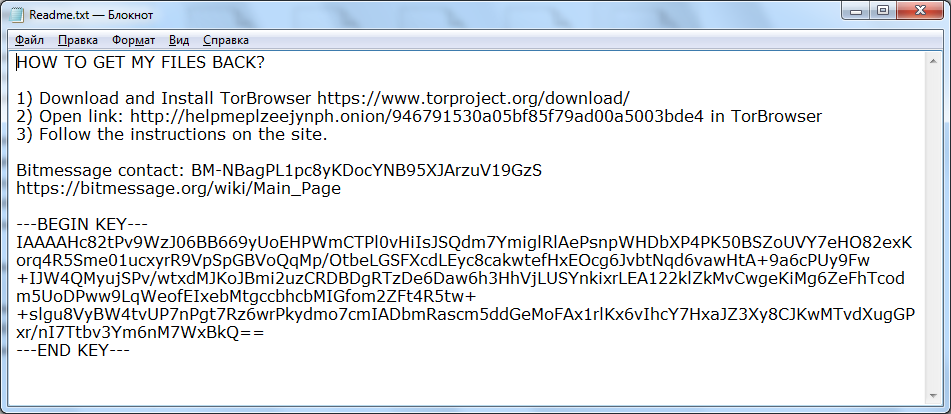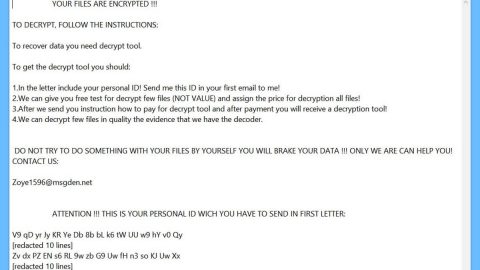What is Ke3q ransomware? And how does it execute its attack?
Ke3q ransomware is a newly spotted data-encrypting virus that happens to be the latest variant of B2DR ransomware. This new B2DR variant uses a “.ke3q” suffix to mark the files it encrypts. Based on the analysis done by security researchers, there are no distinguished changes in this new B2DR strain, save for the extensions it uses and its ransom note.

During the execution of its attack, the crypto-malware is launched in the system using a malicious executable file. This executable file is also responsible for connecting the infected computer to a remote C&C server where it downloads more malicious files. These other malicious files are dropped in the system folder and programmed to stop any programs installed in the system from impeding its attack. These files are also set to modify the Windows Registry, particularly the RunOnce sub-keys to make sure that Ke3q ransomware can run on every system boot. After these alterations, it will begin to look for files with the following extensions:
.3dm, .3g2, .3gp, .7zip, .aaf, .accdb, .aep, .aepx, .aet, .ai, .aif, .as, .as3, .asf, .asp, .asx, .avi, .bmp, .c, .class, .cpp, .cs, .csv, .dat, .db, .dbf, .doc, .docb, .docm, .docx, .dot, .dotm, .dotx, .dwg, .dxf, .efx, .eps, .fla, .flv, .gif, .h, .idml, .iff, .indb, .indd, .indl, .indt, .inx, .jar, .java, .jpeg, .jpg, .js, .m3u, .m3u8, .m4u, .max, .mdb, .mid, .mkv, .mov, .mp3, .mp4, .mpa, .mpeg, .mpg, .msg, .pdb, .pdf, .php, .plb, .pmd, .png, .pot, .potm, .potx, .ppam, .ppj, .pps, .ppsm, .ppsx, .ppt, .pptm, .pptx, .prel, .prproj, .ps, .psd, .py, .ra, .rar, .raw, .rb, .rtf, .sdf, .sdf, .ses, .sldm, .sldx, .sql, .svg, .swf, .tif, .txt, .vcf, .vob, .wav, .wma, .wmv, .wpd, .wps, .xla, .xlam, .xll, .xlm, .xls, .xlsb, .xlsm, .xlsx, .xlt, .xltm, .xltx, .xlw, .xml, .xqx, .xqx, .zip
Ke3q ransomware uses the AES encryption algorithm in encrypting its targeted files just like its predecessor. After it completes encrypting them, it adds the “.Ke3q” suffix to each one of the compromised files. It then releases its ransom note contained in a text file named “Readme.txt” that states:
“HOW TO GET MY FILES BACK?
1) Download and Install TorBrowser https://www.torproject.org/download/
2) Open link: http://helpmeplzeejynph.onion/946791530a05bf85f79ad00a5003bde4 in TorBrowser
3) Follow the instructions on the site.
Bitmessage contact: BM-NBagPL1pc8yKDocYNB95XJArzuV19GzS
https://bitmessage.org/wiki/Main_Page
—BEGIN KEY—
IAAAAHc82tPv9Wz***M7WxBkQ==
—END KEY— [420 symbols]”
If you are one of the unfortunate users who have fallen victim to Ke3q ransomware, contacting them to pay the ransom is certainly not recommended as these crooks are not really known to keep their promises to their victims once they get what they want. Thus, the best way to deal with this threat is to eliminate it from your computer immediately.
How is the malicious payload of Ke3q ransomware disseminated online?
At the time of writing, it isn’t clear how the malicious payload of Ke3q ransomware is disseminated online. However, it could employ malicious spam emails where a corrupted link or file is attached. These infected files are mostly documents with macro scripts which are used to execute some commands to download and install B2DR ransomware into the system. These documents are usually disguised as receipts, invoices, and other seemingly important documents so you need to beware of such tactics used by cybercrooks these days.
To eliminate Ke3q ransomware from your computer, use the removal guide as a reference.
Step_1: First, boot your computer into Safe Mode with Networking, and afterward, you have to terminate the malicious processes of Ke3q ransomware using the Task Manager, and to open it, tap Ctrl + Shift + Esc keys.
Step_2: Go to the Processes tab and look for the malicious processes of Ke3q ransomware and then right-click on it and select End Process or End Task.
Step_3: Close the Task Manager and open Control Panel by pressing the Windows key + R, then type in “appwiz.cpl” and then click OK or press Enter.
Step_4: Look for dubious programs that might be related to Ke3q ransomware and then Uninstall it/them.
Step_5: Close Control Panel and then tap Win + E to launch File Explorer.
Step_6: After opening File Explorer, navigate to the following directories below:
- %TEMP%
- %APPDATA%
- %DESKTOP%
- %USERPROFILE%\Downloads
- C:\ProgramData\local\
Step_7: From these directories, look for the malicious components of Ke3q ransomware such as Readme.txt, [random].exe as well as other dubious files, and then delete all of them.
Before you proceed to the next steps below, make sure that you are tech-savvy enough to the point where you know exactly how to use and navigate your computer’s Registry. Keep in mind that any changes you make will highly impact your computer. To save you trouble and time, you can just use Restoro, this system tool is proven to be safe and excellent enough that hackers won’t be able to hack into it. But if you can manage Windows Registry well, then by all means go on to the next steps.
Step_8: Close the File Explorer and tap Win + R to open Run and then type in Regedit in the field and tap enter to pull up Windows Registry.
Step_9: Navigate to the listed paths below and look for the registry keys and sub-keys created by Ke3q ransomware.
- HKEY_CURRENT_USER\Control Panel\Desktop\
- HKEY_USERS\.DEFAULT\Control Panel\Desktop\
- HKEY_LOCAL_MACHINE\Software\Microsoft\Windows\CurrentVersion\Run
- HKEY_CURRENT_USER\Software\Microsoft\Windows\CurrentVersion\Run
- HKEY_LOCAL_MACHINE\Software\Microsoft\Windows\CurrentVersion\RunOnce
- HKEY_CURRENT_USER\Software\Microsoft\Windows\CurrentVersion\RunOnce
Step_10: Delete the registry keys and sub-keys created by Ke3q ransomware.
Step_11: Close the Registry Editor.
Step_12: Empty your Recycle Bin.
Try to recover your encrypted files using their Shadow Volume copies
Restoring your encrypted files using Windows Previous Versions feature will only be effective if Ke3q ransomware hasn’t deleted the shadow copies of your files. But still, this is one of the best and free methods there is, so it’s definitely worth a shot.
To restore the encrypted file, right-click on it and select Properties, a new window will pop up, then proceed to Previous Versions. It will load the file’s previous version before it was modified. After it loads, select any of the previous versions displayed on the list like the one in the illustration below. And then click the Restore button.
Congratulations, you have just removed Ke3q Ransomware in Windows 10 all by yourself. If you would like to read more helpful articles and tips about various software and hardware visit fixmypcfree.com daily.
Now that’s how you remove Ke3q Ransomware in Windows 10 on a computer. On the other hand, if your computer is going through some system-related issues that have to get fixed, there is a one-click solution known as Restoro you could check out to resolve them.
This program is a useful tool that could repair corrupted registries and optimize your PC’s overall performance. Aside from that, it also cleans out your computer for any junk or corrupted files that help you eliminate any unwanted files from your system. This is basically a solution that’s within your grasp with just a click. It’s easy to use as it is user-friendly. For a complete set of instructions in downloading and using it, refer to the steps below
Perform a full system scan using Restoro. To do so, follow the instructions below.













